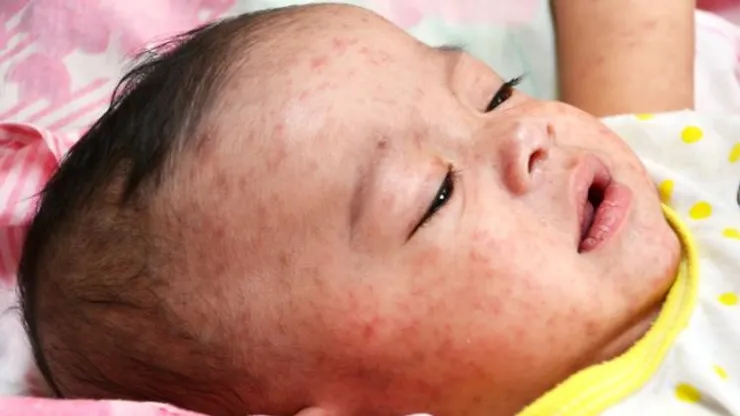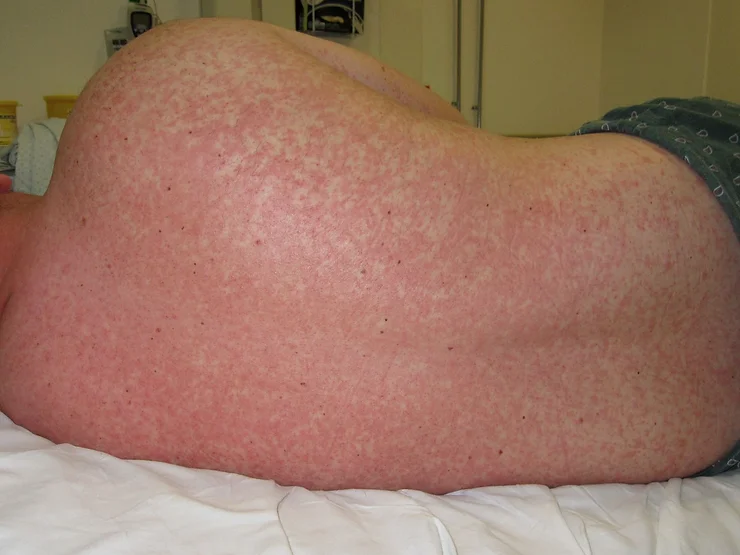Archivist note: This essay was pulled from a 4-year-old blog post of mine, this was for my 8th-grade health final. Please forgive the mistakes.
From January 1 to November 7, 2019, 1,261 cases of measles have been confirmed in 31 states. This is the most report since 1992, 75% of the cases are linked to a measles outbreak in New York. The groups that got it were unvaccinated. 123 people had serious complications, 61 were hospitalized, and reports of complications like pneumonia, and encephalitis. All measles cases this year have been caused by measles wild type D8 or B3. 12 states this year have reports of the measles virus. Why does it spread? The majority of people who get measles are unvaccinated. Travelers with measles continue to bring the disease into the United States. If you think you have it, it might be too late, make sure to get it if you hear someone has it. The name of the vaccine is MMR. Within 7 to 14 days of being infected, the symptoms will begin. You may experience high fever times spiking of 104º. Cough, Coryza, and Conjunctivitis. 2 to 3 days after the symptoms start appearing you will start to get Koplik spots. 3 to 5 days after you will get something called a measles rash. The first thing to do according to the CDC is to call the doctors, measles can be dangerous for very young or immune-compromised people such as elders. Or if you have the following things, (leukemia or HIV infection) are more likely to get measles. CDC recommends all children get two doses of MMR. Starting with the first dose at 12 through 15 months of age, and the second dose at 4 through 6 years of age, children can receive the second dose earlier as long as it is at least 28 days after the first dose. “MMR vaccine is given later than some other childhood vaccines because antibodies transferred from the mother to the baby can provide some protection from disease and make the MMR vaccine less effective until about 1 year of age”.Some of the complacency is an ear infection, this happens with about one out of every 10 children with measles and can result in permanent hearing loss. Another thing is diarrhea, diarrhea is reported in 10 out of every child with measles. Some people may suffer from severe complications, such as pneumonia, and encephalitis, They may need to be hospitalized and could die. Measles may cause pregnant women who have not had the MMR vaccine to give birth prematurely or have a low birth weight. Here are some of the long-term complacencies of measles, some people can develop SSPE, and SSPE General develops within 7 to 10 years after someone’s had measles, even though it has seemed to recover. Since measles was “eliminated” in 2000, zero reports of SSPE have been reported. 4 to 11 out of every 100,000 were estimated to be at risk for developing SSPE. In 2017 the measles virus was eliminated but there is the possibility that it could come back if it comes back you know the symptoms and what to do.



Sources:
https://www.cdc.gov/measles/cases-outbreaks.html https://www.cdc.gov/measles/symptoms/index.html https://www.cdc.gov/measles/symptoms/signs-symptoms.html https://www.cdc.gov/measles/symptoms/complications.html
https://www.cdc.gov/vaccines/vpd/mmr/public/index.html
ninds.nih.gov/Disorders/All-Disorders/Subacute-Sclerosing-Panencephalitis-Information-Page
References
Barrero PR, Grippo J, Viegas M, Mistchenko AS. Wild-type Measles Virus in Brain Tissue of Children with Subacute Sclerosing Panencephalitis, Argentina. Emerg Infect Dis. 2003; 9:1333-1336.Bellini, W.J., Rota, J.S., Lowe L.E., et al. Subacute Sclerosing Panencephalitis: More Cases of this Fatal Disease are Prevented by Measles Immunization than Previously RecognizedExternalexternal icon. J Infect Dis. 2005;192:1686-1693.Bonthius DJ, Stanek N, Grose C. Subacute Sclerosing Panencephalitis, a Measles Complication, in an Internationally Adopted Child. Emerg Infect Dis. 2000. 6:377-381.Campbell H, Andrews N, Brown KE and Miller E. Review of the effect of measles vaccination on the epidemiology of SSPEExternalexternal icon. Int J Epidemiol. 2007;36:1334-1348.Centers for Disease Control and Prevention. Subacute Sclerosing Panencephalitis Surveillance–United States. MMWR. 1982. 31:585-8.Centers for Disease Control and Prevention. Epidemiology and Prevention of Vaccine-Preventable Diseases. Chapter 10, Measles. 8th Edition, 2004.Jin L, Beard S, Brown DWG, Miller E. Characterization of Measles Virus Strains Causing SSPE: A Study of 11 CasesExternalexternal icon. J of Neurovirol. 2002; 8:335-344.Miller C, Farrington CP, Harbert K. The Epidemiology of Subacute Sclerosing Panencephalitis in England and Wales 1970-1989Externalexternal icon. Int J Epidemiol. 1992; 21:998-1006.



